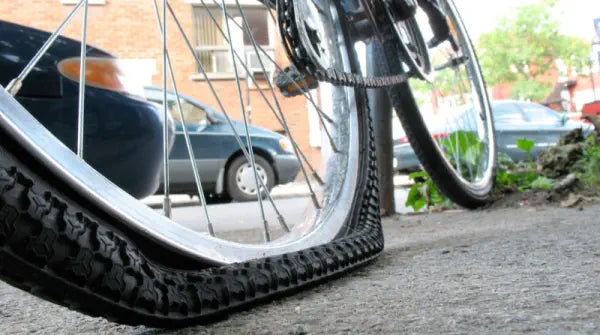
How to fix a puncture
Fixing a puncture is one of those must-have life skills. Even if it’s not for yourself you can guarantee at some point in your life a child or family-member will lean on you for help. So don’t underestimate how important knowing how to fix a puncture is.
This guide assumes you know how to remove and refit a tyre.
If you have a tubeless puncture, read my guide on How to use Tubeless Tyre Plugs
Puncture Repair types
There are a few ways you can fix a puncture. Lets talk about each
- Replace your tube
- Patch your tube
- Use an instant puncture repair sealant
- Convert to Tubeless
Replace your tube
Replacing your tube is one of cleanest, quickest and simplest forms of fixing a puncture. It’s advisable to always a carry a spare tube when out riding or keep one at home, so if the worse happens you can get back on your way as quickly as possible. Especially when it’s bad weather.
Patch your tube
This is what we’ll be focussing on shortly with a how-to guide. There are a couple of different types of patch available. Pre-glued patches are designed for speed and ease. You simply unpeel and stick them on over the hole. However, they are not designed to be a permanent solution like a traditional patch that uses a rubber solution to stick it to your tube. Pre-glued patches will deteriorate and fail eventually whereas correctly fitted traditional patches will last the life of the tube.

Use an instant puncture repair sealant
For the quickest fix in situations like a race where speed is key, instant puncture repair canisters fire sealant and air into your tube and will seal and inflate your tyre in a matter of seconds. But at £10-£20 a go, speed comes at a price.

Convert to Tubeless
If you regularly get punctures, converting to tubeless might be a good idea. It does have benefits in addition to coping with punctures better plus some drawbacks but it is a very popular alternative to traditional inner tubes, particularly on higher volume tyres like MTB. Tubeless isn’t the focus of this article but you can read and understand more in my article How to setup Tubeless Tyres
Further Reading
- Exploring the Pros and Cons of Tubeless Tyres on Electric Bikes
- Ebike Tyres and Tubes – Explained
- How to setup tubeless tyres
Puncture Repair Kits
Puncture repair kits will vary in size and cost depending on their contents. Whether you buy one or pull together the individual parts yourself, this is what a basic kit contains
- Tyre Levers
- Crayon (optional)
- Sand Paper
- Patches (possibly a range of sizes)
- Rubber Solution
- Chalk


What is a slow puncture? This is when air leaks out of the tube or tyre so slowly you can’t hear or see it. A slow puncture may take 24 hours to partially deflate the tyre. The remaining air would need to be removed before fixing it.
How to repair a tube
So let’s walk through how to repair a punctured inner tube
- Deflate the tyre if any air still exists in the case of a slow puncture
- Remove one side of the tyre bead
- Pull the tube out of the tyre, with the valve in place, and inflate it so you can locate the puncture on the tube and the tyre
TIP: If I can’t hear a hiss of air escaping (tiny hole) I run the tube close to my lips and feel for it. Always works. - Mark the puncture location on the tube with a crayon (optional) and deflate it
- Check your tyre for any remaining debris stuck in the carcass at the location you identified in step #3
- Find the puncture location on the tube and roughen the area around it with the sandpaper. This gives the rubber solution a key to stick to. Make the rough area slightly bigger than the size of a patch.
- Spread glue over the roughened area and leave it to cure for at least 5 mins
- Peel the foil off the back of your patch and press it firmly and centrally over the hole holding it there for about a minute.
- Carefully peel back the backing on the patch being careful not to lift the edges of the patch
- Dust the patch with a bit of chalk dust. This prevents it sticking to the inside of the tyre.
- Refit the tube and tyre
- Inflate your tyre
If you find your inner tube is leaking from a faulty valve or around the seat of the valve where it is connected to the tube, you will have to replace it. Patches can’t fix every hole either, regardless of size. Some holes are just to big. Punctured tubes with holes greater than 2-3mm should be replaced.
